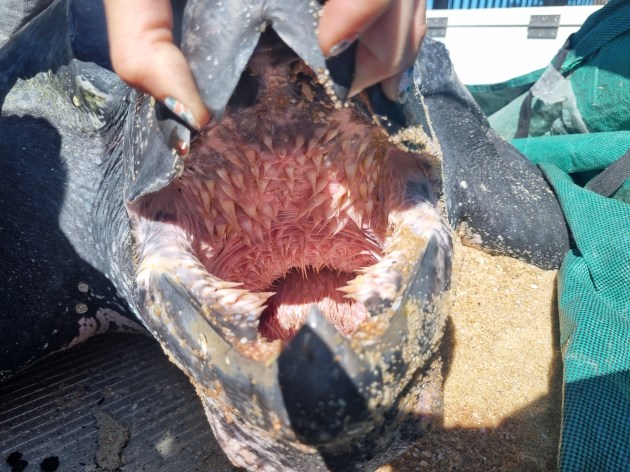What can dive deeper than a submarine, swims across entire oceans, is covered in polka-dots, and has a mouth straight out of a horror movie?
It sounds like the setup for a bad joke, but leatherback sea turtles are all of these things and more. Leatherbacks are perhaps best known for their massive size and unusual carapace. But there’s more to these creatures than you might realize. Read on to learn more about the world’s largest turtle.
Diving Deep
Leatherbacks are one of nature’s deep-diving superstars, capable of descending to ocean depths that would crush other creatures in an instant. The turtles regularly glide down hundreds of feet below the ocean’s surface in search of jellyfish, and they can stay submerged for around 90 minutes on a single breath.
The pressure at these depths is immense, but leatherbacks can cope quite easily thanks to their unique carapace. Unlike other sea turtle species, who have a rigid, bony shell, a leatherback’s carapace is made up of small, interlocking dermal bones, called osteoderms, covered by a thick, leathery skin (hence the name). From a distance, a leatherback’s skin appears dark grey, but get up close and you’ll see that they’re covered in polka-dots, like some great reptilian dalmatian. This design allows their carapace to contract and expand with changing pressure as the turtle moves between different depths.

While dives hundreds of feet down are the norm for leatherbacks, some turtles will occasionally descend to extraordinary depths. A leatherback tagged by Nature Conservancy scientists in 2023 recently broke the record for the deepest dive ever recorded by a marine reptile.
The turtle, nicknamed, Uke Sasakolo, was tagged in the Solomon Islands in December 2023. After laying her eggs, the turtle swam southeast to her foraging grounds in New Zealand. At one point during her journey, she dove at least 1,344 meters (4,409 feet) below the ocean’s surface — a depth equivalent to those reached by US Navy submarines. (The tags record depth within an accuracy of 14.5 meters, so the true depth was between 1,329.5 and 1,358.5 meters.)
That particular turtle has a penchant for deep dives, reaching depths of more than 1,200 meters (>3,900 feet) on four other occasions. The previous leatherback dive record of 1,280 meters (4,199 feet) was recorded in 2006 southwest of Cape Verde, in the Atlantic Ocean.

Marathon Migrations
Uke Sasakolo was tagged as part of a study led by TNC, who worked with conservation rangers to tag 17 leatherback turtles in the Solomon Islands to better understand their migration routes and foraging grounds.
Most of the 17 tagged turtles swam south-east, to the cold, productive waters of New Zealand. A few took more adventurous routes. One turtle headed to the Great Barrier Reef and then onto Papua New Guinea, while another turtle, named Aunty June, swam an astonishing 5,000 miles from the Solomon Islands to the waters off of Baja, California in less than a year.

Leatherbacks have the widest global distribution of any reptile, found in every ocean except the Arctic and Antarctic Oceans. They undertake some of the world’s longest migrations, and turtles from different populations have different migratory routes. The turtles that nest at TNC’s study site in the Solomon Islands swim to foraging grounds near New Zealand, southern Australia, and California. Turtles that nest in the Caribbean head northwards to forage off the coast of Nova Scotia. Eastern Pacific leatherbacks, meanwhile, nest on the coast of Mexico and Costa Rica and migrate south to waters off the west coast of South America. And the leatherbacks that nest in central Indonesia swim north to the South China Sea.
These remarkable journeys are what make protecting this species so difficult. Monitoring and protecting turtles on their nesting beaches is critical, but it’s all for naught if those turtles are hooked on a long-line fishery thousands of miles distant. TNC is working with scientists in New Zealand and Australia to try and protect Haevo’s leatherbacks at their foraging grounds, which overlap with several long-line fisheries.

Little Mouth of Horrors
Take a peak down a leatherback’s throat, and you’ll be greeted with a scene straight out of a horror movie. Their esophagus is coated with backward-curved spines, called esophageal pallipae, which like rhino horns and human fingernails are made from keratin.
Leatherback turtles swallow a lot of seawater as they chomp down on jellyfish, and the pallipae help hold their prey in place as the turtles expel that extra seawater back out of their mouths. Thankfully, leatherbacks aren’t prone to biting humans, but I pity the jellyfish who face their last moments in that terrible maw.
A leatherback’s beak is also specially designed to help it bite down on slippy, squishy prey. Their beak has sharp edges and is curved in a zig-zag pattern, reminiscent of a jack-o-lantern’s grin. Their long, wing-like flippers propel them through the water with surprising grace, given how ungainly they are above the surface. (I know, from personal experience, that being whacked on the shins by one of said flippers is a decidedly unpleasant experience.)

Ancient and Imperiled
The leatherback’s evolutionary origins stretch back into deep time. Their ancestors swam in the oceans 100 million years ago, while tyrannosaurs and triceratops roamed the shorelines.
Today, leatherbacks are considered a globally vulnerable species, with many of their sub-populations declining rapidly. The turtles in the Western Pacific are considered critically endangered, with only 1,400 breeding adults thought to survive.
Nature Conservancy scientists are working with conservation rangers in the Solomon Islands to monitor leatherback nesting beaches. The rangers, which include the country’s first women rangers, gather data on nests, collect eggs and move them to special hatcheries, and help protect the nesting females from poachers.
With any luck, their efforts will help ensure these remarkable giants of the deep survive.




Join the Discussion
9 comments